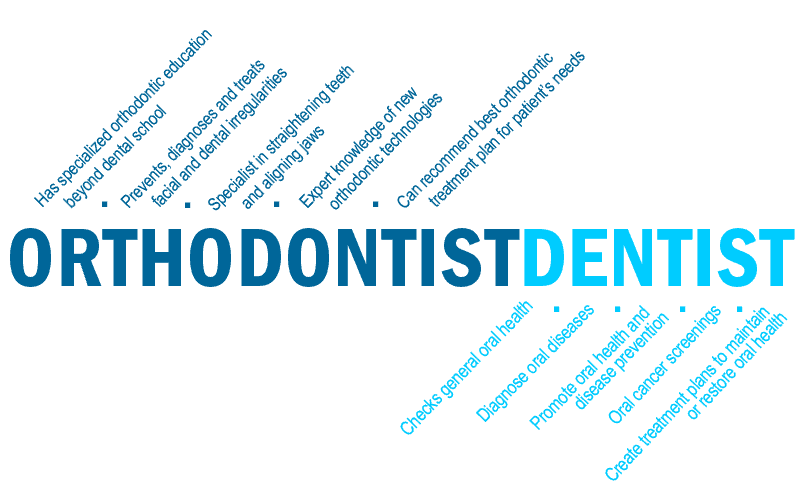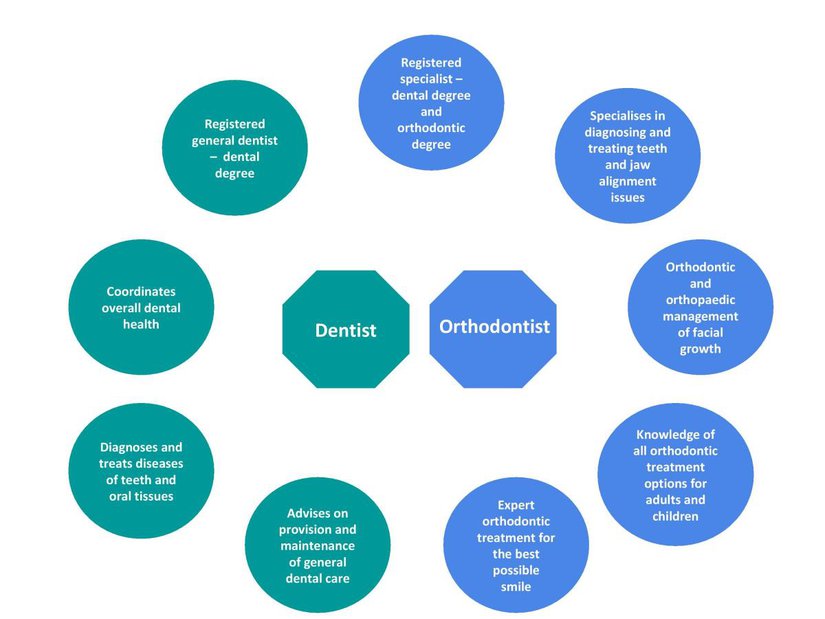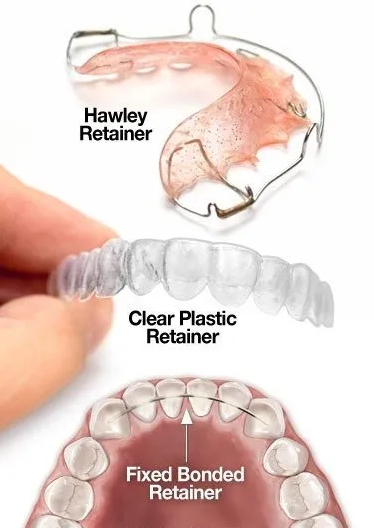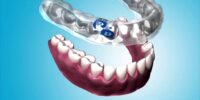Orthodontist meaning explained – role and duties

Definition of Orthodontist
An orthodontist is a specialist who is trained to diagnose and treat these issues using various methods such as braces, retainers, and orthognathic surgery.
Orthodontics is a branch of dentistry that deals with the diagnosis, prevention, and treatment of dental and facial irregularities.
After reading the article you will know what an orthodontist is, the services orthodontists offer, the benefits of orthodontic treatment, and how to find a qualified orthodontist.
Role of an Orthodontist
An orthodontist plays a vital role in the field of dentistry by diagnosing and treating dental and facial irregularities. They are responsible for creating treatment plans to correct dental problems.
The ultimate goal of an orthodontist is to improve the alignment of teeth and jaws, which can lead to improved oral health, enhanced self-esteem and confidence, better speech and bite function, and a beautiful, healthy smile. Additionally, orthodontist also work with other dental specialist like oral surgeons, periodontist and general dentist to ensure comprehensive treatment plan and best outcome for the patient.
Responsibilities and duties of an orthodontist
- Diagnosis and Assessment: Orthodontists begin by conducting thorough assessments of patients’ dental and facial structures. They use X-rays, photographs, and other diagnostic tools to evaluate the alignment of teeth and jaws.
- Treatment Planning: After diagnosis, orthodontists develop personalized treatment plans based on the specific needs and goals of each patient. These plans may include the use of braces, aligners, or other orthodontic appliances.
- Braces Installation and Adjustments: Orthodontists are responsible for the precise placement of braces or other appliances on patients’ teeth. They also make regular adjustments to these appliances to ensure that the teeth are gradually and correctly aligned.
- Invisalign or Clear Aligner Treatment: Some orthodontists offer Invisalign or clear aligner treatment, which involves designing and overseeing the use of removable, transparent aligners to straighten teeth.
- Monitoring Progress: Orthodontists closely monitor their patients’ progress throughout the treatment process. Regular check-up appointments are essential to assess the alignment and make any necessary adjustments.
- Treatment for Malocclusions: Orthodontists treat various malocclusions, including overbites, underbites, crossbites, open bites, and crowded or spaced teeth.
- Providing Patient Education: Orthodontists educate patients and their families about proper oral hygiene practices during orthodontic treatment. They emphasize the importance of maintaining good oral health to prevent issues such as tooth decay and gum disease.
- Orthognathic Surgery Coordination: In some cases, orthodontists work in conjunction with oral and maxillofacial surgeons to correct severe jaw irregularities through orthognathic (jaw) surgery.
- Records Keeping: Orthodontists maintain detailed records of patient treatment plans, progress, and outcomes for reference and documentation.
- Staying Current with Advances: As with all medical professionals, orthodontists must stay up-to-date with the latest developments in their field through continuing education and attending seminars and conferences.
- Patient Communication: Effective communication with patients and their families is crucial. Orthodontists explain treatment options, expected outcomes, and potential risks to ensure informed decision-making.
- Managing Orthodontic Staff: In a private practice, orthodontists may manage a team of orthodontic assistants, hygienists, and administrative staff.
- Collaboration: Orthodontists often collaborate with general dentists, pediatric dentists, and other dental specialists when a patient’s dental health requires comprehensive care.
- Research and Innovation: Some orthodontists engage in research to advance the field and contribute to the development of new orthodontic techniques and materials.
- Ethical and Professional Standards: Orthodontists are held to high ethical and professional standards in their patient care, ensuring that they provide safe and effective treatments.
What is an Orthodontist?
An orthodontist is a dental specialist who has completed an additional two to three years of education and training beyond dental school.
Orthodontists are trained to diagnose, prevent, and treat dental and facial irregularities, including misaligned teeth, bite problems, and jaw imbalances. They use a variety of methods such as traditional metal braces, clear braces, Invisalign, and retainers to correct these issues. They also provide orthognathic surgery, which is a procedure used to correct jaw imbalances and improve bite function.

Education and Training
An orthodontist is a dental specialist who has completed an extensive education and training beyond dental school. In order to become an orthodontist, individuals must first graduate from an accredited dental school and obtain a DDS or DMD degree. After dental school, they must then complete an additional two to three years of postgraduate education and training in an accredited orthodontic program.
This education and training includes the study of the diagnosis, prevention, and treatment of dental and facial irregularities, as well as the use of various orthodontic methods and techniques. Additionally, orthodontist must pass a rigorous examination from governing bodies such as the American Board of Orthodontics (ABO) or the Royal College of Dentist of Canada (RCDC) to obtain their certification as an orthodontist.
The education and training of an orthodontist is extensive and ongoing, as they are required to complete continuing education courses to maintain their certification and stay current with the latest advances in the field.
Specializations and Services
- Traditional Metal Braces: Orthodontists use metal braces to correct misaligned teeth and improve bite function.
- Clear Braces: Clear braces are similar to traditional metal braces but are made of clear or tooth-colored materials, making them less noticeable.
- Invisalign: This is a clear, removable alternative to traditional braces that uses a series of custom-made aligners to gradually shift teeth into proper alignment.
- Retainers: Retainers are used to maintain the alignment of teeth after orthodontic treatment.
- Orthognathic Surgery: This is a specialized area of orthodontics that involves surgical intervention to correct jaw imbalances and improve bite function.
- Sleep Apnea treatment: orthodontists also provide treatment options for sleep apnea by correcting jaw alignment and position of the tongue.
- Craniofacial Anomaly: Orthodontists also work with other dental specialists and medical professional to treat craniofacial anomaly such as cleft lip and palate.
- Temporomandibular Joint (TMJ) disorder: orthodontist also provide treatment options for TMJ disorder by correcting bite and jaw alignment
- Early treatment: Orthodontists also provide early treatment options for children with developing dental and facial irregularities.
- Adult Orthodontic treatment: orthodontists also provide treatment options for adult patients who want to correct their dental and facial irregularities.
Differences between Orthodontist and Dentist
Orthodontists and dentists are both healthcare professionals who specialize in oral health, but they have different areas of expertise and perform different types of procedures.
The main difference between orthodontists and dentists is their level of education and training. Dentists complete a four-year undergraduate degree and four years of dental school to earn a DDS or DMD degree, while orthodontists complete an additional two to three years of postgraduate education and training in an accredited orthodontic program.
Orthodontists specialize in diagnosing and treating dental and facial irregularities, with a focus on the alignment of teeth and jaws. They create treatment plans to correct issues such as misaligned teeth, bite problems, and jaw imbalances.
Dentists, on the other hand, provide a wide range of general dental services, including teeth cleaning, fillings, extractions, and root canals. They also provide preventative care and can diagnose and treat a variety of oral health problems.

Common orthodontic treatments
Braces
Braces are one of the most common orthodontic treatments used to correct misaligned teeth and improve bite function. There are several different types of braces available, each with their own unique characteristics:
- Traditional Metal Braces: These are the most common type of braces, consisting of metal brackets and wires that are attached to the teeth. The brackets and wires apply pressure to the teeth to gradually shift them into proper alignment.
- Clear Braces: Clear braces are similar to traditional metal braces, but they are made of clear or tooth-colored materials, making them less noticeable. They use the same principles as traditional metal braces to shift teeth into proper alignment.
- Ceramic Braces: Ceramic braces are similar to traditional metal braces, but they are made of ceramic material. Ceramic braces are less visible than metal braces but are more fragile than metal braces.
- Self-Ligating Braces: These are similar to traditional metal braces, but they use a special clip instead of elastic bands to hold the wire in place. This allows for more comfortable and efficient treatment.
- Lingual Braces: Lingual braces are similar to traditional metal braces, but they are placed on the back of the teeth, making them invisible from the front.
- Invisalign: Invisalign is an alternative to traditional braces, consisting of a series of clear, removable aligners that gradually shift the teeth into proper alignment.
Retainers

Retainers are another common orthodontic treatment used to maintain the position of teeth after orthodontic treatment. There are several different types of retainers available:
- Fixed Retainers: These retainers are cemented or bonded onto the back of the teeth, typically on the lower arch, and are not removable by the patient. They are usually used when the patient has a high risk of relapse.
- Removable Retainers: These are the most common type of retainers, which are removable by the patient. They typically consist of a plastic or acrylic piece that fits over the teeth, and are held in place by wire or springs. These retainers are worn at night or as recommended by the orthodontist.
- Clear Retainers: Clear retainers are similar to removable retainers but are made of clear plastic, making them less visible. They are worn to maintain the position of the teeth.
- Functional Retainers: These are retainers worn on the lower arch that are designed to correct jaw or bite issues. They are worn for a specific period of time as prescribed by the orthodontist.
Orthognathic surgery
Orthognathic surgery, also known as jaw surgery, is a type of orthodontic treatment used to correct severe bite and jaw alignment issues that cannot be corrected with braces alone. There are several different types of orthognathic surgeries that can be performed, including:
- Maxillary osteotomy: This surgery is performed on the upper jaw to correct issues with the upper teeth and bite.
- Mandibular osteotomy: This surgery is performed on the lower jaw to correct issues with the lower teeth and bite.
- Sagittal split osteotomy: This surgery is used to correct a wide range of jaw issues, including a recessed lower jaw and an overbite.
- Genioplasty: This surgery is used to correct a recessed or projecting chin.
- Orthognathic surgery is typically performed in a hospital under general anesthesia. Recovery time varies depending on the type of surgery and the individual case, but it can take several weeks to several months for the patient to fully recover.
Benefits of Orthodontic Treatment
Orthodontic treatment can have many benefits for oral health, including:
- Improved teeth alignment: Crooked or crowded teeth are harder to clean and maintain, which can lead to an increased risk of tooth decay and gum disease. Orthodontic treatment can align teeth and improve their appearance, making it easier to keep them clean and healthy.
- Improved bite: Malocclusion, or a bad bite, can cause excessive wear on certain teeth, leading to tooth damage or loss. Orthodontic treatment can correct bite issues and prevent further damage.
- Reduced risk of TMJ disorders: TMJ disorders are a group of conditions that affect the jaw joint and muscles. Orthodontic treatment can help to correct jaw alignment and reduce the risk of developing TMJ disorders.
- Improved self-esteem: A beautiful smile can boost self-esteem and confidence, especially in children and teenagers. Orthodontic treatment can improve the appearance of teeth and give patients a reason to smile.
- Improved speech: Orthodontic treatment can correct bite issues that can affect speech.
How to find a qualified Orthodontist
When it comes to finding a qualified orthodontist, there are a few things to keep in mind. The American Association of Orthodontists (AAO) is a great place to start your search. They have a directory of orthodontists that have met the AAO’s high standards of education and experience. You can also ask friends and family for recommendations, or research orthodontists in your area.
American Association of Orthodontists

One way to find a qualified orthodontist is by using the American Association of Orthodontists (AAO). The AAO is the professional organization for orthodontists in the United States, and its members are required to meet certain education and experience requirements.
Here are some steps you can take to find a qualified orthodontist using the AAO:
- Visit the AAO website (www.aaortho.org) and click on the “Find an Orthodontist” link.
- Enter your zip code, city, or state to find orthodontists in your area.
- The search results will provide a list of AAO member orthodontists in your area.
- You can filter your search results by orthodontist’s name, distance from your location, and/or type of treatment offered.
- You can click on the orthodontist’s name to view more information about them, such as their education and experience, the services they offer, and patient reviews.
- Once you have found a qualified orthodontist that meets your needs, contact them to schedule a consultation.
It is important to note that being a member of the AAO does not guarantee the quality of the orthodontist’s work, but it is a good indication that the orthodontist meets the minimum educational and ethical standards set by the AAO
Research and ask for recommendations
Another way to find a qualified orthodontist is by doing research and asking for recommendations. Here are some steps you can take to find a qualified orthodontist using research and recommendations:
- Ask for recommendations from your general dentist or other healthcare professionals you trust. They may have experience working with orthodontists and can give you an idea of which ones are reputable and have a good reputation in your area.
- Do research online. Many orthodontists have websites that provide information about their qualifications, services offered, and patient reviews. You can also check online directories and review sites to get an idea of what other patients have experienced with different orthodontists.
- Check the orthodontist’s credentials. Look for orthodontists that are certified by the American Board of Orthodontics (ABO) or members of the American Association of Orthodontists (AAO). These certifications and memberships indicate that the orthodontist meets certain education and experience requirements.
- Ask about the orthodontist’s experience. Look for orthodontists who have been practicing for several years and have experience treating a wide range of cases.
- Visit the orthodontist’s office and meet with the orthodontist. Take note of the office’s cleanliness, the staff’s professionalism, and the overall atmosphere of the office.
- Ask about the orthodontist’s treatment philosophy and approach. Make sure it aligns with your own preferences and goals.
- Read reviews and testimonials from other patients. This will give you an idea of the orthodontist’s bedside manner and the results they’ve achieved for other patients.
Recap of key points
- An orthodontist is a dental specialist who focuses on the diagnosis, prevention, and treatment of dental and facial irregularities.
- Orthodontists complete additional education and training after dental school, including a 2-3 year residency program.
- Orthodontists offer a wide range of specializations and services, including traditional braces, clear aligners, and orthognathic surgery.
- The main difference between orthodontists and dentists is that orthodontists have specialized training in straightening teeth and correcting jaw alignment.
- Common orthodontic treatments include braces, retainers, and orthognathic surgery.
- Orthodontic treatment can improve oral health, self-esteem, and overall appearance.
- Finding a qualified orthodontist can be done by researching credentials, asking for recommendations, and visiting the orthodontist’s office.
- American Association of Orthodontist (AAO) is a good resource for finding qualified orthodontist.
If you have any concerns about the appearance or function of your teeth or bite, we highly recommend seeking the help of a qualified orthodontist. Orthodontists are dental specialists who are trained to diagnose, prevent, and treat a wide range of dental and facial irregularities. From traditional metal braces to clear aligners, orthodontists have a variety of treatment options available to help straighten teeth and improve the overall appearance and function of your bite.
Don’t let concerns about your teeth or bite hold you back from feeling confident and enjoying good oral health. The first step is to schedule a consultation with a qualified orthodontist to discuss your options and determine the best course of treatment for your individual needs. With the help of an orthodontist, you can achieve the straight, healthy smile you’ve always wanted.








